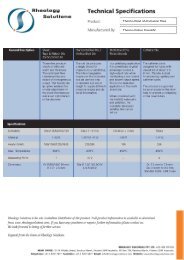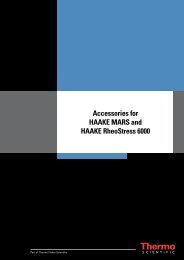Download - Rheology Solutions
Download - Rheology Solutions
Download - Rheology Solutions
You also want an ePaper? Increase the reach of your titles
YUMPU automatically turns print PDFs into web optimized ePapers that Google loves.
continued from page 25<br />
and other impurities. By measuring the transmitted<br />
light through a polymer film, the CCD camera<br />
processes the image and identifies discontinuities<br />
in the film.<br />
The camera scans an area of 400 mm2 at a rate<br />
of 4 pictures per second, with a resolution to 60 μ<br />
m. There are options for higher resolution on a<br />
smaller area or scanning a larger area at a lower<br />
resolution.<br />
The results can be displayed and analysed on<br />
different formats. This first display logs the counts<br />
of different particle sizes over time.<br />
This analysis gives the distribution of particle sizes<br />
over the test.<br />
Finally this analysis shows the distribution of<br />
particles by size and frequency.<br />
Other applications of the twin-screw use the<br />
dedicated ancillary equipment that designed to<br />
make up the EUROLAB System.<br />
biennial 07-08<br />
Pelletising<br />
When samples are required in pellet form, then a<br />
strand die and traditional cooling bath and<br />
pelletiser are used. This system includes a variable<br />
length pelletiser, where the pellet length can be<br />
selected from 1mm to 3mm in 0.5mm steps. If<br />
mini-pellets are needed for micro-moulding, them<br />
a combination of high draw-down with high cutter<br />
rotation will give 1mm X 1mm pellets.<br />
When working with highly filled compounds, or<br />
water sensitive products, an air quench, face cut<br />
system is available. Here the product is cut on the<br />
face of the die, propelled into an air stream and<br />
conveyed to a cyclone for collection. This method<br />
is also very useful for new water sensitive,<br />
biodegradable polymers being studied today.<br />
Data Logging<br />
When many different materials need sampling, it is<br />
very useful to be able to record operating<br />
conditions so that reproducible samples can be<br />
prepared. This can be even more reliable if the key<br />
operating conditions can be recorded and stored<br />
as a recipe for future use. The touch screen<br />
interface and PLC control allow this to be done<br />
simply, with added security of password<br />
protection.<br />
Scale-up<br />
In any laboratory system, the operator is always<br />
concerned with scale-up to larger production scale<br />
equipment. Form our experience the most critical<br />
element in this scale-up, is heat transfer capability.<br />
Most twin-screw extruders are variable speed, and<br />
so shear rates can be matched between laboratory<br />
and production extruders. Residence time in the<br />
extruder depends on a combination of product<br />
feed rate and screw speeds. Because generally<br />
output is determined by the motor power installed,<br />
and that is usually scaled to the volume of the<br />
extruder, which again gives a good scale up.<br />
However, heat transfer in dependent on the<br />
surface area to volume ratio. This means that the<br />
ratio of surface area to volume is inversely<br />
proportional to the barrel diameter. i.e. if you<br />
double the diameter of the screws, then volume<br />
(and hence output) will increase by 8 times while<br />
surface area, and (hence heat transfer capability)<br />
will increase only 4 times.<br />
Surface Area, Free Volume<br />
relationships<br />
Conclusion<br />
In a modern masterbatch plant, quality control and<br />
product sampling are key factors in the efficient<br />
operation. By using small-scale extruders, fitted<br />
with suitable ancillaries, and with reliability in<br />
scale-up, the operator can have confidence in<br />
developing new materials and formulations. This<br />
paper has shown availability of such equipment.<br />
A copy of this article is available on request by<br />
quoting LR-51<br />
26 www.rheologysolutions.com










